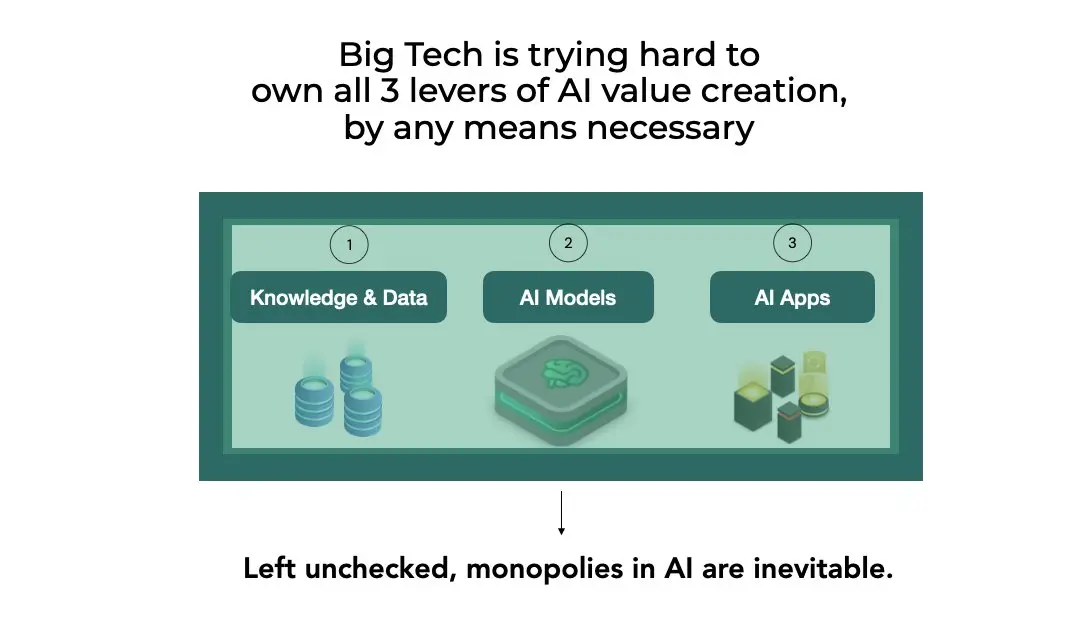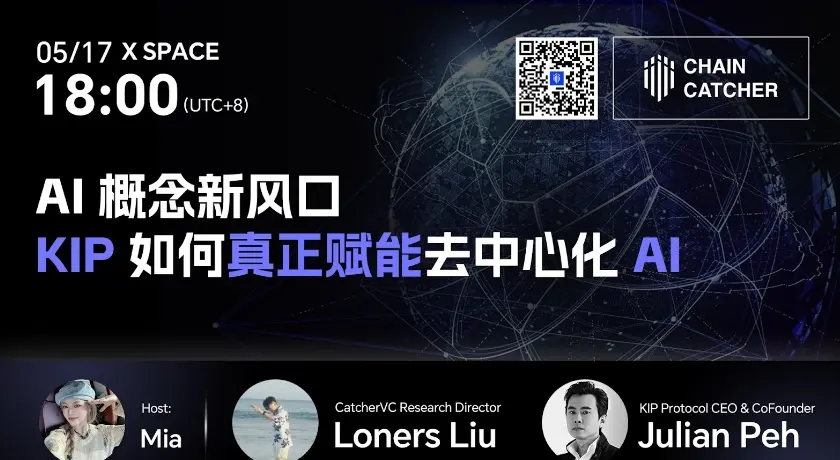Understanding the AI-focused decentralized Web3 underlying protocol KIP Protocol #1
Author: KIP Protocol
First of all, KIP is not just an AI app, nor is it a large language model, and it is certainly not a database/knowledge base.
KIP Protocol is a decentralized underlying protocol built for AI app developers, model creators, and data owners to securely transact and monetize in Web3. KIP enables valuable knowledge and data to be protected and monetized as knowledge assets, ensuring interaction with AI without losing ownership.
For AI app developers, model creators, and data owners, it will be found to be crucial for decentralized work and monetization in Web3.
(We refer to these three categories as: AI value creators)
The decentralization of AI is an extremely vast and important topic, with several pioneering projects taking different approaches to address this issue.
KIP focuses on solving the fundamental problems that AI value creators face when attempting to deploy and monetize their work in Web3.
AI Models Need Apps and Data to Create Economic Value

In the field of AI, there are over 20 different categories of companies providing solutions, yet most of the attention on generative AI in the past year has been focused on AI models (with a plethora of different categories and methods, from transformers to generative adversarial networks to diffusion models, and so on).
In fact, these models represent a true breakthrough in computing for this new era—underlying the true intelligence.
However, to establish a commercial ecosystem in AI, models need to rely on at least two other key value creators.
1) AI Apps: 'The Face of AI'
In the frenzy over models, it's easy to overlook the importance of apps.
AI apps are crucial for guiding users into the AI realm. These apps can take various forms, such as chatbots, image generators, search bots, analytical bots, or even some simple prompts.
They accumulate user experiences to gain users and, perhaps most importantly, collect fees from users.
Many people forget that ChatGPT is an app from OpenAI, powered by various models (GPT 3.5, GPT 4) from OpenAI. The groundbreaking human-like responses of the OpenAI chatbot are primarily coded on the app side rather than the model side. (This can be inferred by connecting the model directly through the app interface and comparing the answers.)
In short: without apps, models are just a bunch of code sitting in a metal box, completely unusable.
2) Data: 'The Foundation of AI'
Data is crucial in the following aspects:
- a) Model training and fine-tuning,
- b) Retrieval-Augmented Generation (RAG)
All models are trained and fine-tuned through data. Without fine-tuning, models cannot become more powerful or intelligent.
However, using data to fine-tune or train models essentially "assimilates" or "absorbs" the data into the model, manifested as adjustments to the model weights.
Therefore, in situations where it is impossible, impractical, or illegal to use data to directly train models, an innovative technology known as "Retrieval-Augmented Generation" (RAG) can come into play.
RAG combines the ability to retrieve information from external databases with the capability of generating responses through AI models. It's like having a super-intelligent assistant that understands your questions and knows where to find answers, even if it doesn't know the answers itself.
While RAG is still a relatively new technology, we firmly believe that as data sensitivity and protection concepts increase, RAG technology could become a leading approach, bringing significant commercial value through practical applications and becoming the mainstream framework for most people to access AI in the future.
Regardless of the approach taken, sustainable AI innovation is impossible without data.
A vibrant AI ecosystem requires the integration of value creators from different industries.
Some individuals and companies that excel at training and fine-tuning models may not be adept at designing and marketing customer-facing apps.
Similarly, researchers and domain experts with valuable datasets and knowledge bases may lack the skills to train AI models or design apps.
However, in a vibrant and diverse ecosystem, they do not have to go it alone. Companies and individuals from different industries can collaborate to create use cases and economic value for users.
App designers can choose the AI models that best fit their product plans and pre-select external knowledge bases that are most helpful to users.
But what if these three different industry talents are slowly absorbed into a closed ecosystem?
Because that is exactly what is happening right now. We will discuss this issue in detail in future articles, but for now: please search online for "openai copyright protection" and consider the implications of AI on data ownership in the future.

Why Does KIP Want to Promote AI Decentralization?
The monopoly in the AI field poses unique dangers, and the decentralization of AI is an urgent and necessary response to the subjugation of our collective interests to narrow corporate interests.
We fully support AI accelerationism (e/acc), and we never deny the significant contributions that large tech companies have made in driving AI innovation.
However, the actions of most companies tend to ruthlessly aim at maximizing shareholder interests. This is the nature of capitalism; expecting them to change their nature and ignore their driving motives is to deny reality.
We need to establish a counterbalancing state in the AI field, allowing many different participants to enter the market and compete, thereby creating an environment where innovation can thrive. The future of AI must never succumb to the corporate interests of any giant company.
We believe that the decentralization of AI is the only way to achieve this ideal state.
How Does KIP Promote AI Decentralization?

KIP addresses three fundamental problems that AI model creators, app developers, and data owners will face when attempting to decentralize.
1) On-chain/Off-chain Connection
2) Monetization and Realization
3) Ownership and Security Issues
1) The "On-chain/Off-chain Connection" Issue
There are over 400,000 models on the open-source model library company Hugging Face, indicating how vibrant the entire AI industry is, but it is still just getting started.
Current blockchain technology cannot provide the core inference capabilities of models (i.e., fully decentralized models) at a cost or speed acceptable to most ordinary users (although advancements in edge computing may soon help us achieve this goal).
Therefore, even if not all, most models are off-chain models, and we can expect more innovation and supplementation in off-chain models.
To unleash all these ideas and innovations in web3, KIP can easily perform inference on-chain.
KIP allows heavy computational tasks related to machine learning inference to be handled outside the blockchain while still maintaining the integrity and principles of a decentralized system.
2) The "Revenue" Issue

No matter how good the technology is, it will not be adopted if users cannot enjoy more economic benefits.
The basic revenue model framework for AI can be described as "pay-per-query," as each user query consumes GPU computing power, and someone must pay for it. Answering a user query requires multiple AI value creators to respond to the question.
We do not advocate decentralization for the sake of decentralization, but rather as an alternative to monopoly.
Therefore, for AI decentralization to succeed, we must ensure that all parties involved in decentralizing AI work can earn revenue.
While this sounds easy, it is not as simple as it sounds in the AI field.
Let’s take an example of running a query through RAG
- The user asks a question to the AI chatbot.
- The AI chatbot forwards the query to its brain—the AI model.
- The model retrieves only the relevant data blocks needed to answer the question from the knowledge base, formulates the answer, and sends it back to the app.
- The app packages the answer and sends it to the user.
In this simplified example, you can see how all three roles contribute to answering the user query.
In a centralized ecosystem, if one platform owns and controls all three roles (as OpenAI aims to do in the second image above), then you only need to pay that centralized platform, and the rest are internal transfers.
But if we want decentralization instead of monopoly, then each party needs to be paid, which requires solving the following issues:
- Recording (on-chain) the contributions of each party
- Distributing revenue from users
- Ensuring everyone can earn their own income
This is the "revenue" issue that KIP aims to solve for decentralized AI.
We achieve this through a low-cost, high-efficiency Web3 infrastructure that provides connections between AI value creators, methods for charging users, and ways to extract revenue. (We will introduce this in the upcoming Understanding KIP Series).
If the revenue issue is not addressed first, the decentralization of AI will become more difficult, and widespread adoption will be unlikely, except among a few true idealistic supporters.
3) The "Ownership" Issue
Monetization is merely a weak privilege if it is not tied to true ownership.
We have all seen how accounts on centralized platforms can be closed or banned at any time.
KIP addresses this issue by using blockchain tokens, specifically ERC-3525 tokens (SFT), to "represent" the outputs of AI value creators.
1. For Data Owners: SFT represents vectorized knowledge bases or links to encrypted raw data files used for model training.
2. For Model Creators: SFT can represent an API to off-chain models or a set of weight models available for sale.
3. For App Developers: SFT can represent front-end APIs or prompts themselves.
These SFTs act as "monetization entities," allowing for interaction on-chain and recording the amount earned by each SFT from specific transactions.
By addressing these issues, KIP enables AI value creators to easily achieve decentralization in their work, creating the initial conditions for a vibrant and larger decentralized AI ecosystem.
KIP is the decentralized Web3 underlying protocol necessary for AI innovation.
About KIP Protocol
KIP Protocol builds a Web3 underlying protocol for AI app developers, model creators, and data owners, enabling AI assets to be easily deployed and monetized while retaining full digital ownership.
KIP will establish a new AI business ecosystem to address the challenges and issues faced in decentralized AI deployment, ensuring that everyone can enjoy the economic benefits brought by AI.
The KIP team consists of senior PhDs and technical experts dedicated to AI research since 2019, who also have a strong professional background and rich experience in the Web3 field, committed to promoting AI decentralization and becoming a catalytic force in the wave of decentralized AI.
For more information, please follow our official account:









